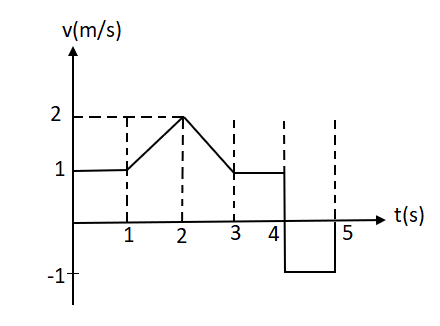
The velocity-time graph of a body is shown below. The displacement covered by body in 5 s is

A. 2m
B. 4m
C. 3m
D. 1m
Answer
219k+ views
Hint:If we find the value of the area in the velocity time graph we get the resultant value of displacement. On the other hand, the area count is defined as the distance covered by the body.
Formula used:
Area of triangle is given as
\[\dfrac{1}{2} \times b \times h\]
Where b is base and h is height.
Area of square=side\[ \times \]side
Complete step by step solution:
In the velocity-time graph of a body as shown in the figure, the x-axis represents time in the second and the y-axis represents velocity in m/s.
Let from 0 s to 1 s area is \[{A_1}\], Area of square=side\[ \times \]side=\[1 \times 1\]
from 1 s to 2 s area is \[{A_2}\], Area of triangle=\[\dfrac{1}{2} \times b \times h\]
from 2 s to 3 s area is \[{A_3}\], Area of triangle=\[\dfrac{1}{2} \times b \times h\]
from 3 s to 4 s area is \[{A_4}\], Area of square=side\[ \times \]side=\[1 \times 1\]
from 4 s to 5 s area is \[{A_5}\], Area of square=side\[ \times \]side=\[ - (1 \times 1)\] , Here the negative sign shows time axis is the negative so velocity is in negative direction.
As we know the area enclosed in the velocity-time graph is equal to the displacement. Now the displacement (d) covered by the body in 5 s is calculated as,
Displacement,
\[d = {A_1} + {A_2} + {A_3} + {A_4} + {A_5}\]
\[\Rightarrow d = (1 \times 1) + \left( {\dfrac{1}{2} \times 1 \times 1} \right) + \left( {\dfrac{1}{2} \times 1 \times 1} \right) + (1 \times 1) - (1 \times 1)\]
$\therefore d= 2\,m$
Therefore, the displacement covered by the body in 5 s is 2 m.
Hence option A is the correct answer.
Note:A velocity-time graph can show the speed as well as direction an object can travel within a definite period of time. Velocity-time graphs are also known as speed-time graphs. The y-axis of a velocity-time graph represents the velocity of the object and the x-axis represents the time of the object.
Formula used:
Area of triangle is given as
\[\dfrac{1}{2} \times b \times h\]
Where b is base and h is height.
Area of square=side\[ \times \]side
Complete step by step solution:
In the velocity-time graph of a body as shown in the figure, the x-axis represents time in the second and the y-axis represents velocity in m/s.
Let from 0 s to 1 s area is \[{A_1}\], Area of square=side\[ \times \]side=\[1 \times 1\]
from 1 s to 2 s area is \[{A_2}\], Area of triangle=\[\dfrac{1}{2} \times b \times h\]
from 2 s to 3 s area is \[{A_3}\], Area of triangle=\[\dfrac{1}{2} \times b \times h\]
from 3 s to 4 s area is \[{A_4}\], Area of square=side\[ \times \]side=\[1 \times 1\]
from 4 s to 5 s area is \[{A_5}\], Area of square=side\[ \times \]side=\[ - (1 \times 1)\] , Here the negative sign shows time axis is the negative so velocity is in negative direction.
As we know the area enclosed in the velocity-time graph is equal to the displacement. Now the displacement (d) covered by the body in 5 s is calculated as,
Displacement,
\[d = {A_1} + {A_2} + {A_3} + {A_4} + {A_5}\]
\[\Rightarrow d = (1 \times 1) + \left( {\dfrac{1}{2} \times 1 \times 1} \right) + \left( {\dfrac{1}{2} \times 1 \times 1} \right) + (1 \times 1) - (1 \times 1)\]
$\therefore d= 2\,m$
Therefore, the displacement covered by the body in 5 s is 2 m.
Hence option A is the correct answer.
Note:A velocity-time graph can show the speed as well as direction an object can travel within a definite period of time. Velocity-time graphs are also known as speed-time graphs. The y-axis of a velocity-time graph represents the velocity of the object and the x-axis represents the time of the object.
Recently Updated Pages
Two discs which are rotating about their respective class 11 physics JEE_Main

A ladder rests against a frictionless vertical wall class 11 physics JEE_Main

Two simple pendulums of lengths 1 m and 16 m respectively class 11 physics JEE_Main

The slopes of isothermal and adiabatic curves are related class 11 physics JEE_Main

A trolly falling freely on an inclined plane as shown class 11 physics JEE_Main

The masses M1 and M2M2 M1 are released from rest Using class 11 physics JEE_Main

Trending doubts
JEE Main 2026: Application Form Open, Exam Dates, Syllabus, Eligibility & Question Papers

Understanding Uniform Acceleration in Physics

Derivation of Equation of Trajectory Explained for Students

Hybridisation in Chemistry – Concept, Types & Applications

Understanding the Angle of Deviation in a Prism

Understanding Collisions: Types and Examples for Students

Other Pages
JEE Advanced Marks vs Ranks 2025: Understanding Category-wise Qualifying Marks and Previous Year Cut-offs

Units And Measurements Class 11 Physics Chapter 1 CBSE Notes - 2025-26

NCERT Solutions For Class 11 Physics Chapter 8 Mechanical Properties Of Solids

Motion in a Straight Line Class 11 Physics Chapter 2 CBSE Notes - 2025-26

NCERT Solutions for Class 11 Physics Chapter 7 Gravitation 2025-26

Understanding Atomic Structure for Beginners




